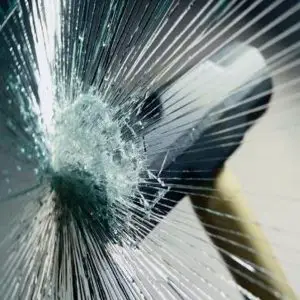If you’ve ever wondered what impact resistant means for glass, then gere’s a quick and easy guide to understanding how impact resistant glass works and what it can do.
What is impact resistant glass?
Impact resistant glass is a type of glass that is designed to be more resistant to shattering or breaking than regular glass. This type of glass is often used in applications where there is a potential for impact, such as in windows or windshields in vehicles. Impact resistant glass may also be referred to as safety glass.
How is impact resistant glass made?
Impact resistant glass is made with a layer of polyvinyl butyral (PVB) laminated between two layers of tempered soda lime glass. The PVB interlayer functions as an adhesive to keep the layers of glass together during impact. Though the PVB layer is only about 0.030 inches thick, it significantly increases the overall strength and impact resistance of the glass.
What are the different types of impact resistant glass?
There are four main types of impact resistant glass:
- Tempered glass: This type of glass is treated with heat and pressure to make it stronger and more resistant to shattering.
- Laminated glass: Laminated glass is made by bonding two or more layers of glass together with a plastic interlayer. This makes the glass stronger and more resistant to shattering.
- Wired glass: Wired glass is made by embedding wires in the glass to give it strength and resistance to shattering.
- Polycarbonate glass: Polycarbonate glass is a strong, lightweight plastic that is often used in bulletproofing because it is resistant to shattering.
What are the benefits of impact resistant glass?
Some of the benefits of impact resistant glass include:
- Increased safety: Impact resistant glass is designed to be much stronger than regular glass, meaning that it is less likely to break and cause injuries.
- Improved security: In a building or vehicle resistant glass can be an effective deterrent against burglaries and other forms of forced entry, as it is much more difficult to break than regular glass.
- Reduced noise: Impact resistant glass is also effective at reducing interior vehicle noise and cutting down noise pollution from outside buildings. This makes it ideal for use in high-noise areas such as construction sites.
Are My Glasses Impact Resistant?
There are a few ways to tell if your glasses are impact resistant. One way is to look for the “Z87” stamp on the inside of the frame. This indicates that the glasses meet ANSI Z87.1 safety standards for impact resistance.
Another way to tell if your glasses are impact resistant is to look for the “Includes Free Protective Case” sticker on the outside of the frame. This case is made of a hard material that can help protect your glasses from impact in case of an accident.
If you’re not sure whether or not your glasses are impact resistant, you can always contact the manufacturer or retailer to ask.
What are the standards for impact resistant glass?
There are currently two main standards for impact resistant glass – ANSI Z87.1 and CE EN 166.
- ANSI Z87.1 is an American standard, covering both eyewear and face shields, developed by the American National Standards Institute.
- CE EN 166 is a European standard, developed by the European Committee for Standardization, covering personal eye protection.
Do note that not all impact resistant glasses need to meet both standards – manufacturers will typically make their glasses to either ANSI or CE EN 166 (or sometimes both), depending on their target market.
How do I care for my impact resistant glasses?
You should treat your impact resistant glasses the same way you would any other pair of glasses. Be sure to clean them regularly with gentle soap and water or commercially available cleaning solutions and cloths designed specifically for cleaning eyeglasses. You can also use a soft, dry cloth to remove smudges.
FAQs about impact resistant glass
Q: What is impact resistant glass?
A: Impact resistant glass is a type of safety glass that is designed to be resistant to shattering. It is made by adding a layer of tough plastic or resin to the glass, which helps to absorb the force of impact and prevent the glass from breaking.
Q: How does impact resistant glass work?
A: When an object strikes impact resistant glass, the force of the impact is spread evenly across the surface of the glass. This helps to prevent the glass from shattering or breaking. The tough plastic or resin layer also helps to absorb some of the force, further reducing the risk of breakage.
Q: Is impact resistant glass shatterproof?
A: No, impact resistant glass is not shatterproof. While it is designed to be resistant to shattering, it is not impossible for the glass to break. However, the risk of breakage is significantly reduced when compared to regular glass.
Q: What are the benefits of using impact resistant glass?
A: There are several benefits associated with using impact resistant glass. First, it helps to reduce the risk of injury in case of an accident or breakage. Second, it can help to reduce damage to property, as shattered glass can cause extensive damage. Finally, it can help to improve security as it is more difficult for burglars and intruders to breaking throughimpact resistantglass.
In Closing
The term ‘impact resistant glass’ can mean different things, depending on which type of glass it is. Make sure to check the label and ratings of the impact resistant glass you are considering to make sure it can handle the environment it will be in.
NEXT UP: Are Impact Glasses Bulletproof?


